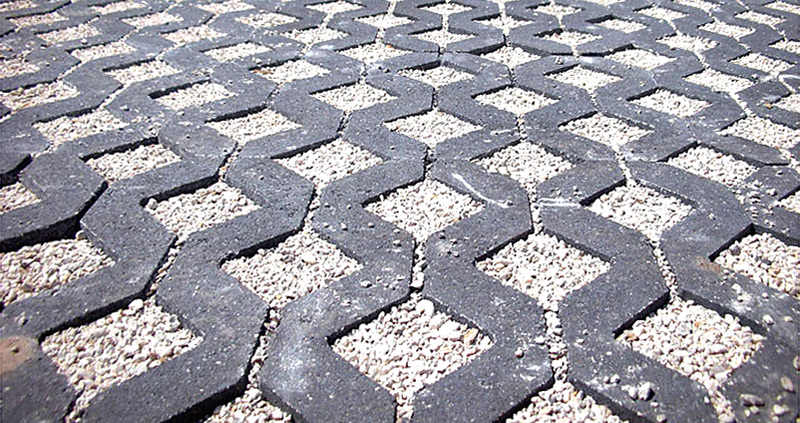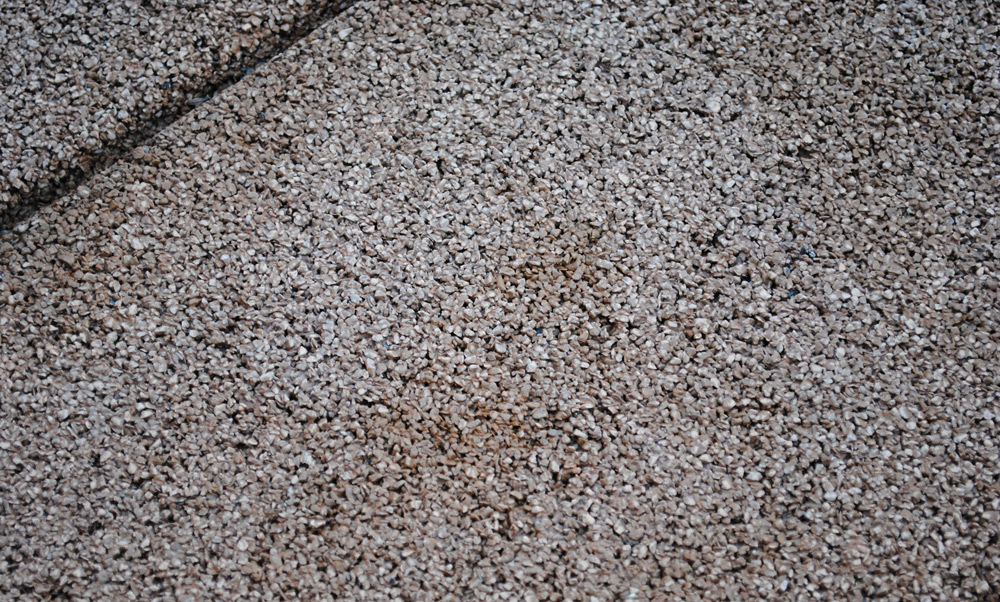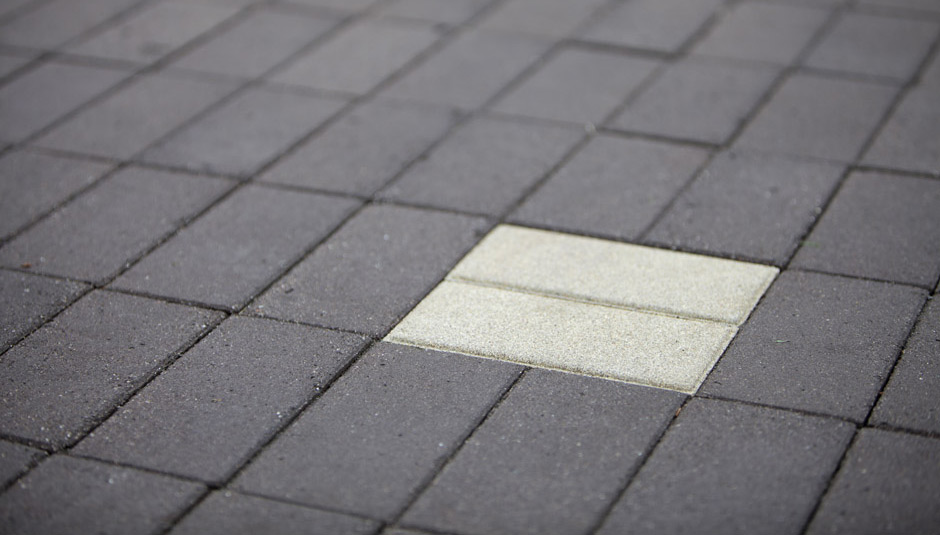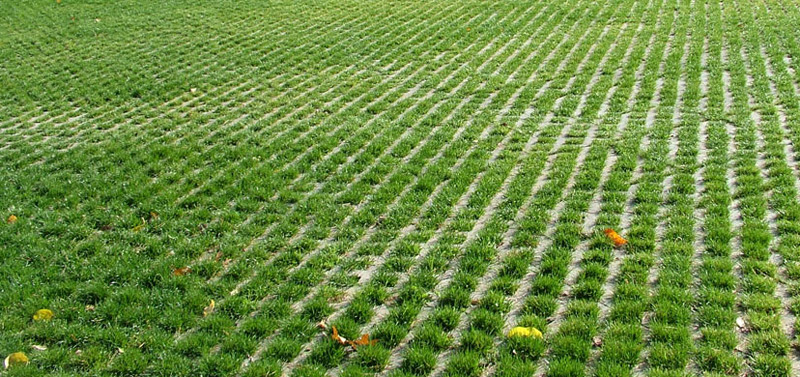
[image source: Expocrete]
With most residential work, be it a new home or a remodel, the design of the exterior “hardscape” is just as important as the home itself. These areas can include an entry sidewalk and its sequence of experiences leading up to the front door, a deck or a private courtyard integral to the home, or something as utilitarian as a driveway to the garage. In a nutshell, we’re talking about any hard surface areas exposed to the elements. Rather than being afterthoughts or secondary design elements, these features are central to the overall planning of the site. Traditionally, these hard surfaces prevented rain water from reaching the ground below and were considered impermeable by most building departments. But this is changing, and there are a variety of hard surface applications that allow for stable, flat surfaces, all while allowing rain water to pass through to the ground below.

[image source: Enhance Companies]
These engineered materials are becoming increasingly important to architecture, construction and the permitting process. Most urban and suburban jurisdictions operate with land use codes that now limit the amount of lot coverage and impervious surface area on a parcel*. Doing so controls the amount of rainwater at the source, reduces runoff of storm water and improves water quality by filtering the pollutants within the soil itself. In the Pacific Northwest, for instance, the maximum allowable impervious surface area ranges from around 15 to 35 percent of the total parcel (depending on how the city or county has zoned the property). Once this limit is reached with the impervious surface area, no further development can occur on site. Because permeable surfaces are excluded from this calculation, they allow the addition of hardscapes without the penalty of impervious surface area—it allows the homeowner to have their cake and eat it too.
We work with a high frequency of challenging sites; sites which are usually governed by stringent zoning codes, and we typically need to be conscientious and careful of the allowable impervious surface area. This has necessitated a kit-of-parts over the years that include some reliable and cost-effective permeable surfaces. Today’s post breaks our findings down into three groups:
POROUS ASPHALT PAVEMENT
Pervious asphalt, permeable asphalt, porous concrete

[image source: Julie Orr Design]
Think of it like Rice-Krispies treats with a higher compressive strength and not quite as tasty.
Effective permeability range: 16-25%
Compressive strength: up to 4,000 psi
Required thickness: 4″ – 8”
Technology: The deletion of fine aggregate allows for connected voids while the coarse aggregate is coated with enough cementitious paste to hold it all together
Application: Areas with light traffic, driveways, pedestrian walkways, bike paths
Cost: $3 – $10 per square foot (extremely dependent on size of job)
Other considerations: Typically requires additional layers of sub-base material or filter fabric

[image source: BC Concrete]
PERMEABLE PAVING UNITS
Pervious pavers, porous pavers

[image credit: Aroura LLC]
Because the technology here is ceramic-based, these systems are typically proprietary. We like the Aroura Klorostone product for its clean aesthetic, simple color options and versatility.
Permeability: The Klorostone is capable of infiltrating up to 2 inches of stormwater per minute without relying on mortar gaps. The exact permeability is difficult to determine with these products because each company has its own protected recipe.
Compressive strength: 6,000 psi
Thickness: 2-3/8″
Technology: Each individual paving unit is porous (as opposed to interlocking concrete that relies on aggregate gaps for infiltration)
Application: Driveways, sidewalks, courtyards, patios
Cost: $7 – $10/sf delivered
Available colors: 4
Other considerations: The joints around paving units will provide an additional 5-15% of permeable area

[image credit: Aroura LLC]
http://www.youtube.com/watch?v=ml58jfjc46Q&feature=youtu.be
OPEN CELL PAVERS
Grass-crete pavers, interlocking cell pavers, precast concrete cells

[image source: Western Interlock]
We’re big fans of the Belgard Turfstone pavers because of the large paver size (24” x 16”); this size can be used for a continuous surface or it’s just wide enough to accommodate two tire strips for an inconspicuous driveway.
Permeability: The units preserve 40% of earth area and allow water to pass directly through to the earth below.
Compressive strength: 8000 psi
Thickness: 3-1/8”
Technology: Concrete and holes, it’s simple and straight-forward (just how we like it)
Application: We like to use it for courtyards or understated driveways
Cost: ~$5/sf
Available colors: Gray
Other considerations: Fill the open cells with moss or grass for a softer visual (it also helps keep the site cooler)

[image source: Scheftic Construction]
*It’s worth noting that gravel is considered an impervious surface by many jurisdictions and its inclusion on a project will count against the impervious surface calculations. From the King County website:
“Packed gravel prevents or impedes the entry of water into the soil as compared to natural conditions. Scientific studies show that once gravel is compacted (from cars or heavy equipment, for example), the gravel acts like paved surfaces and surface water runs off it in greater quantities than compared to natural conditions. In addition, if cars or heavy equipment are traveling on these gravel surfaces, pollution such as dissolved minerals or residual petroleum are washed off into our waterways.”
There’s tons of products out there that help with the permeability of surfaces in our built-environment, share what you know and feel free to add to our list of favorite products.
Cheers from Team BUILD
Additional sources:
Wikipedia, U.S. EPA, Dauphin County Conservation District, NRMCA, Tree Hugger





